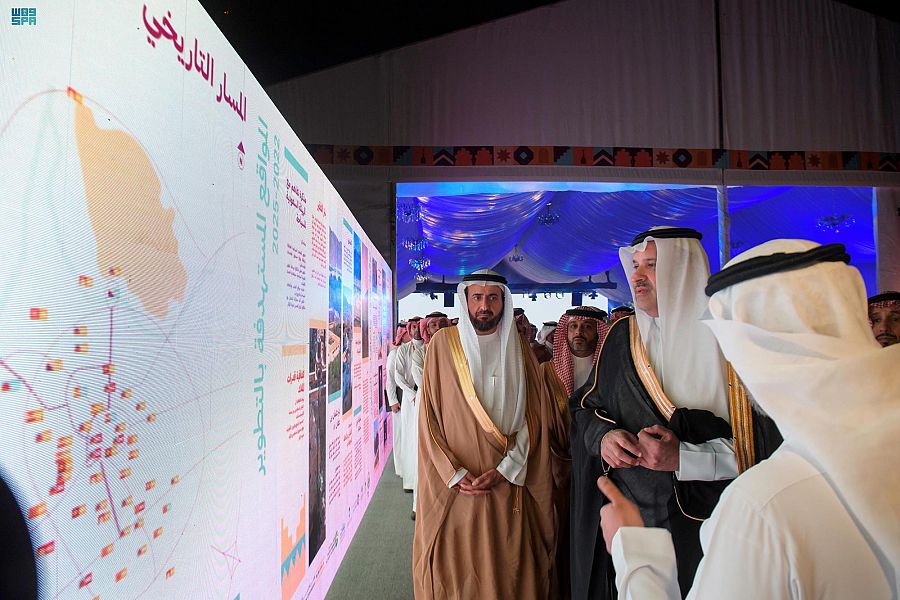
RIYADH: More than 100 sites in Madinah with connections to the life of the Prophet Muhammad and other important events in Islamic history will be restored and developed as part of a three-year package of projects that was announced by Saudi authorities on Wednesday and will run until 2025.
Unveiled during a ceremony inaugurated by Governor of Madinah Prince Faisal bin Salman, the projects include restorations of the site of the Battle of the (Trench), Al-Faqir well, and Al-Qiblatayn Mosque.
An agreement has also been signed for renovations at Uthman bin Affan well and Sayed Al-Shuhada Square, and work is underway on studies for restoration work at more than 100 other historical Islamic sites in Madinah.
Governor of Madinah Prince Faisal bin Salman and the the Minister of Hajj and Umrah Tawfiq Al-Rabiah attend the inauguration ceremony on Wednesday. (Supplied)
During the ceremony, which was organized by Al-Madinah Region Development Authority, the Saudi Heritage Authority, and the Pilgrims Experience Program, heritage chiefs also announced that eight Islamic historical sites in Madinah have already been restored to their former glory: Al-Ghamama Mosque, Abu Bakr Al-Siddiq Mosque, Umar ibn Al-Khattab Mosque, Al-Saqiya Mosque, Banu Anif Mosque, Al-Rayah Mosque, Ghars Well, and the fort at Arwa bin Al-Zubair Castle.
Tawfiq Al-Rabiah, the minister of Hajj and Umrah and chairman of the Islamic Historical Sites Committee, thanked the governor of Madinah and said the committee is working to turn the desire of the Saudi leadership to preserve Islamic heritage into a reality that can be enjoyed by pilgrims and other visitors.
He added that the “Kingdom seeks, through projects, to rehabilitate and activate historical sites, to open its doors to pilgrims and visitors from all over the world, enabling them to enjoy a rich cultural experience” through which they can explore Islamic historical treasures and learn about authentic Saudi culture.
Governor of Madinah Prince Faisal bin Salman and the the Minister of Hajj and Umrah Tawfiq Al-Rabiah attend the inauguration ceremony on Wednesday. (Supplied)
Find out more about the eight sites that have been renovated:
Al-Ghamama Mosque:
Located near the Prophet’s Mosque, it was built by Umar bin Abdul Aziz at a place where the Prophet Muhammad worshipped during Eid and prayed for rain. The site was also used by Uthman bin Affan for the same purpose.
Abu Bakr Al-Siddiq Mosque:
Built using a wonderful architectural style, this is the second of two sites where the Prophet Muhammad performed Eid prayers during his lifetime. First caliph of the Rashidun Caliphate Abu Bakr Al-Siddiq also prayed here during Eid, hence its name. It was built by Umar bin Abdul Aziz.
Umar ibn Al-Khattab Mosque:
Located in Al-Musallah, this mosque was named after Umar ibn Al-Khattab, the second caliph of the Rashidun Caliphate.
Al-Saqiya Mosque:
The name of this mosque came from its proximity to the Saqia well.
Banu Anif Mosque:
Originally built from basalt and located southwest of Quba Mosque, only about two meters of its walls remained before it was renovated.
Ghars Well:
A well from which the Prophet Muhammad drew water. He asked that when he died, his body be washed in water from the well before burial.
Al-Rayah Mosque:
Built by Caliph Umar bin Abdul Aziz on the site where the Prophet Muhammad prayed while supervising the digging of the trench ahead of the Battle of the (Trench).
The fort at Arwa bin Al-Zubair castle:
A defensive fortress built of volcanic rock, used for military protection.












